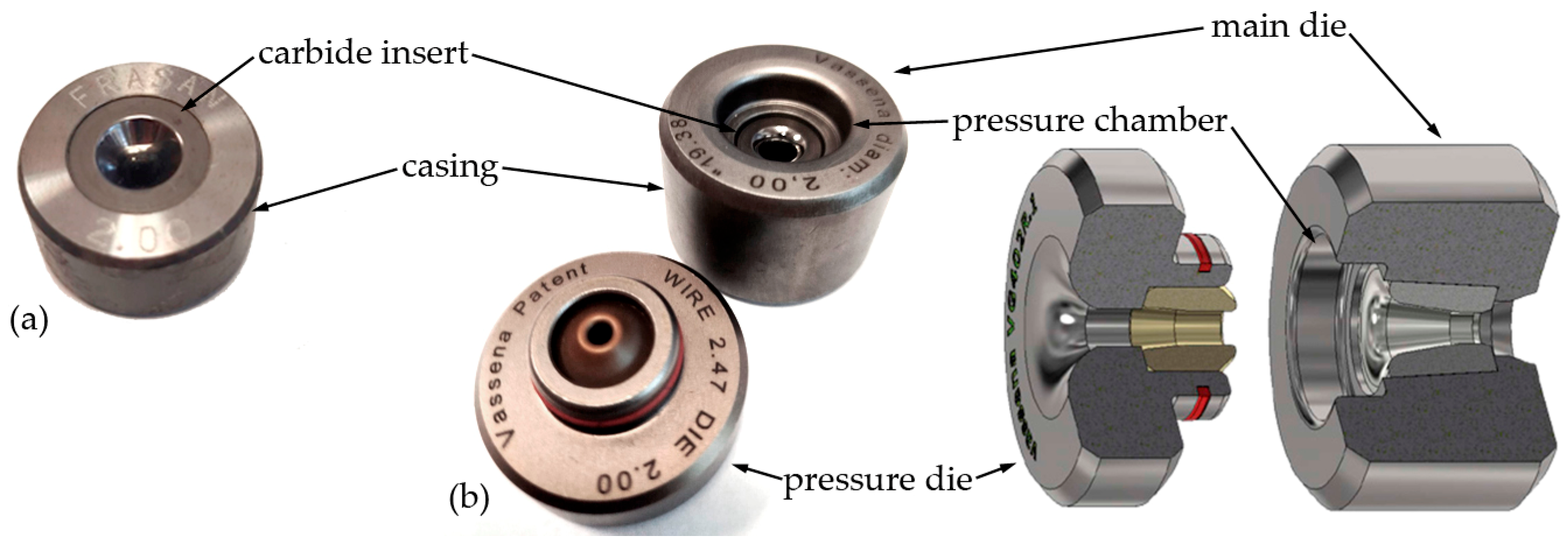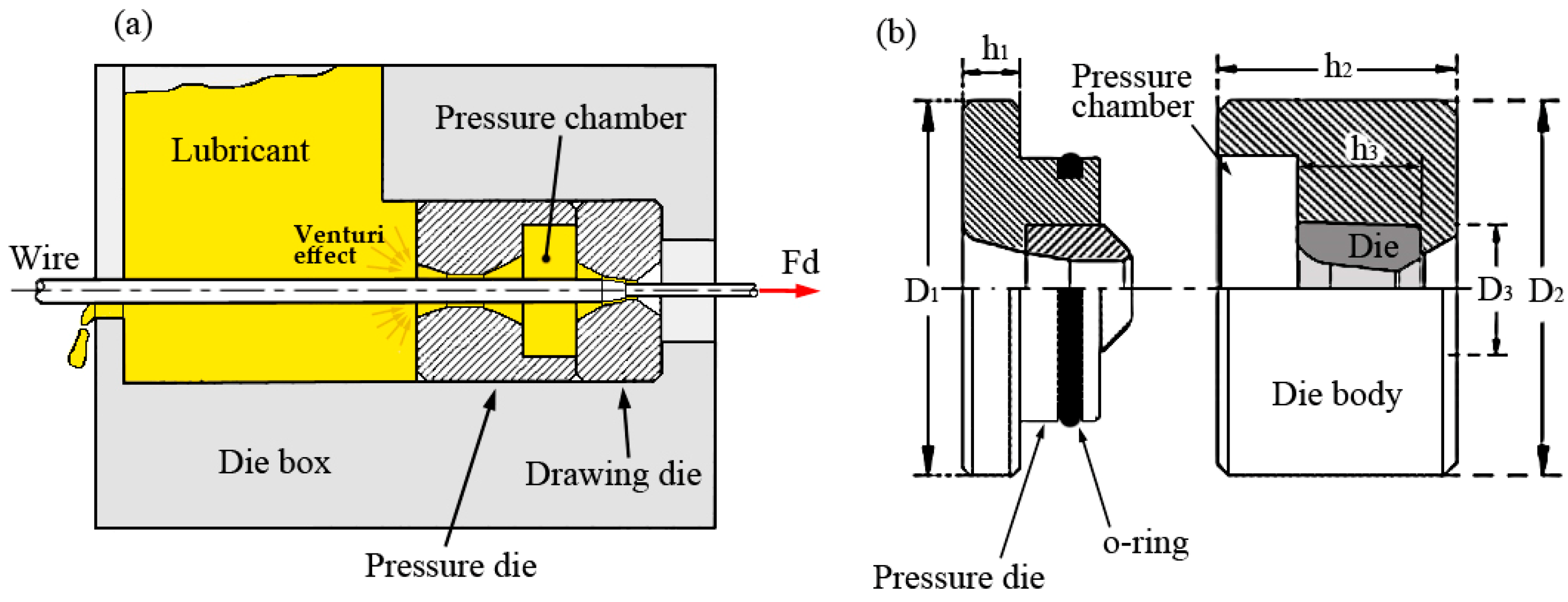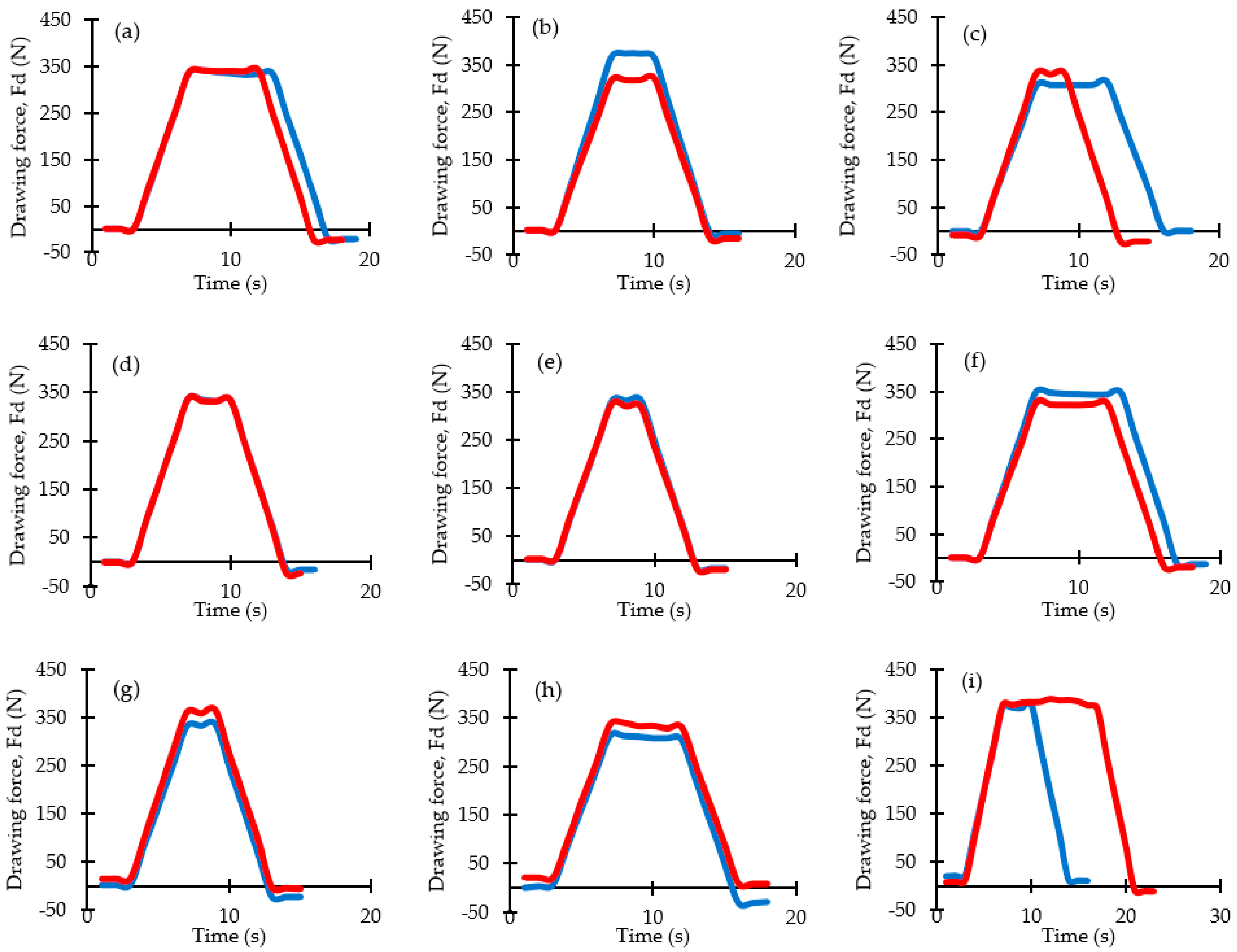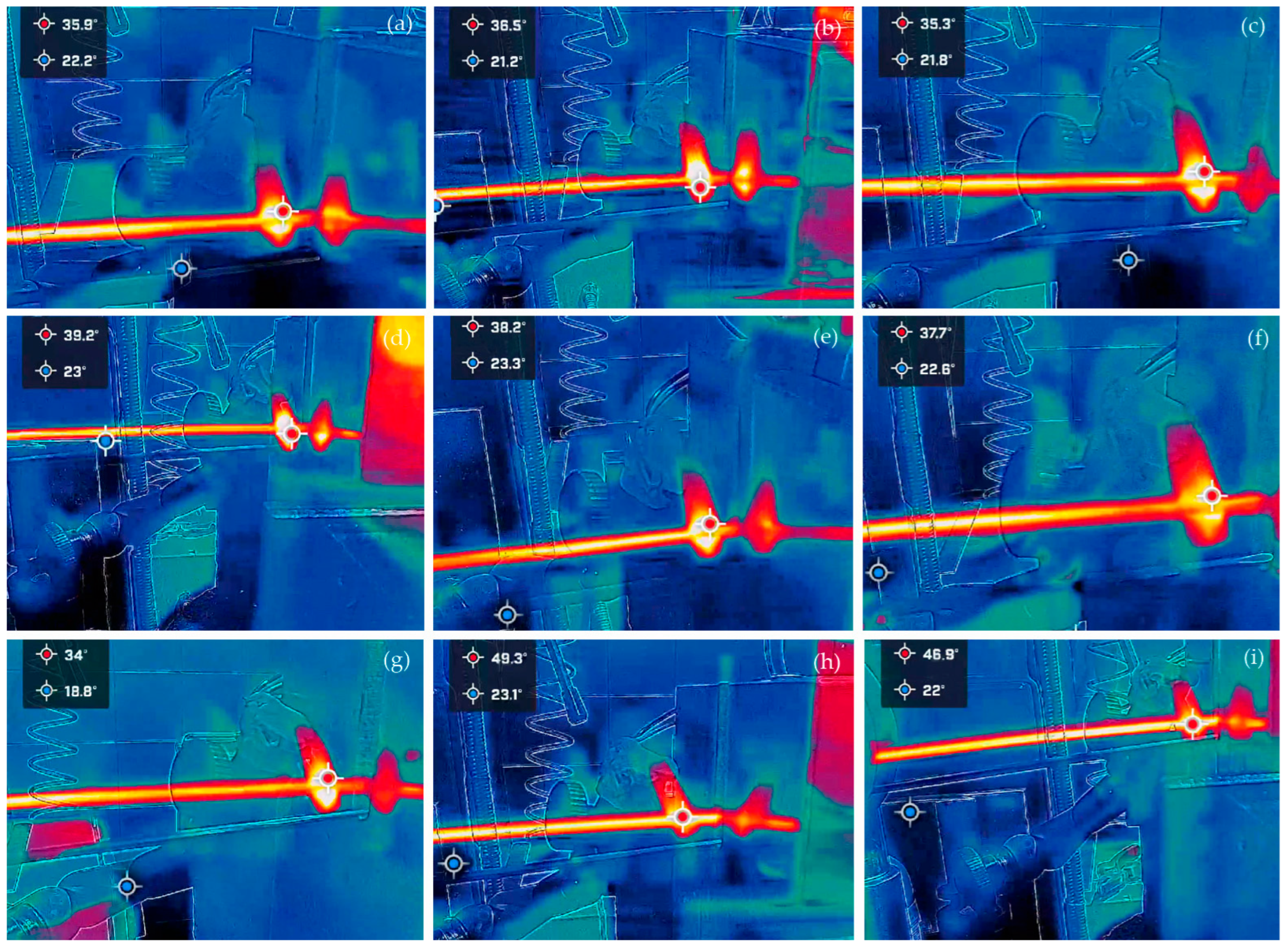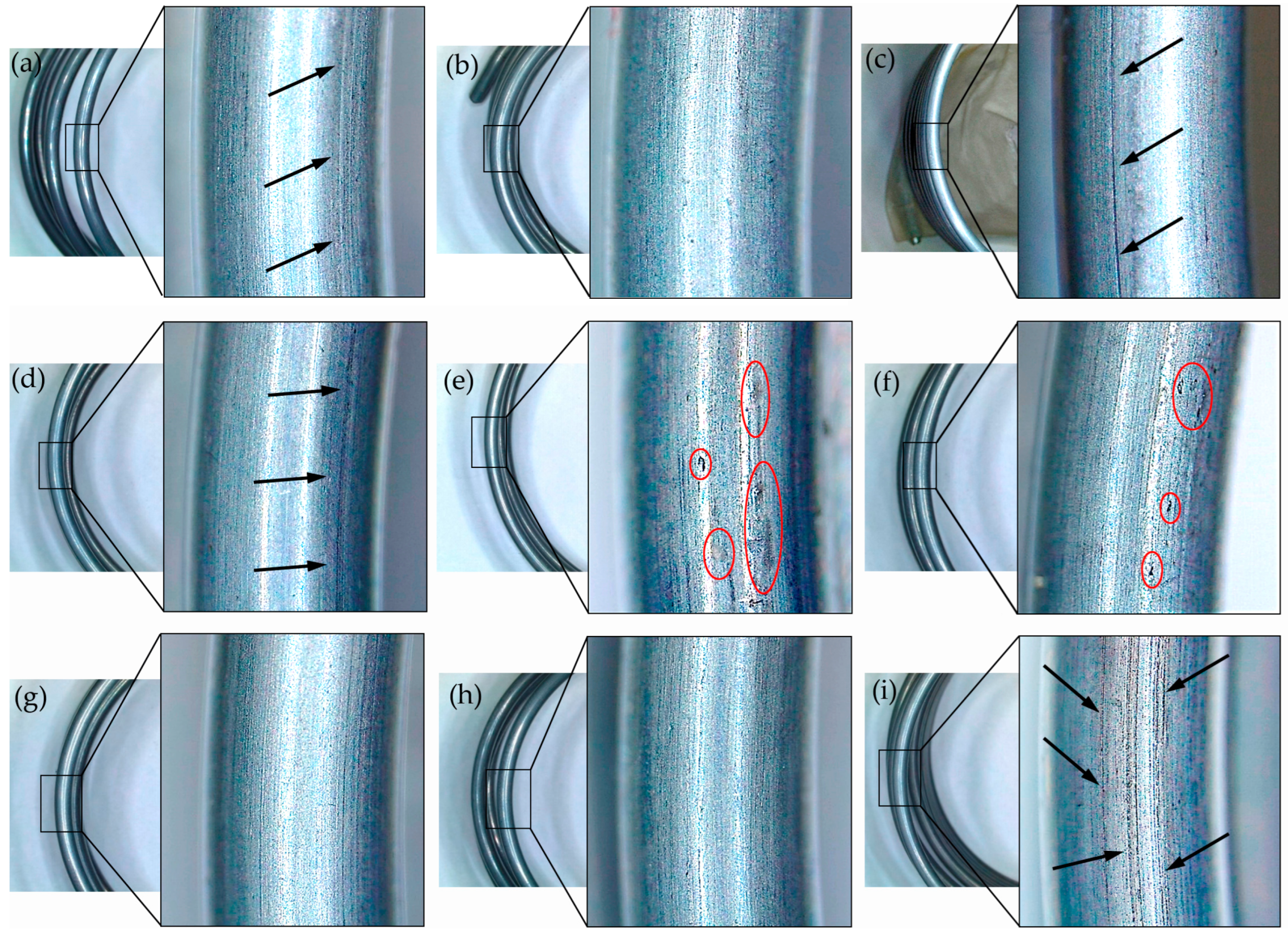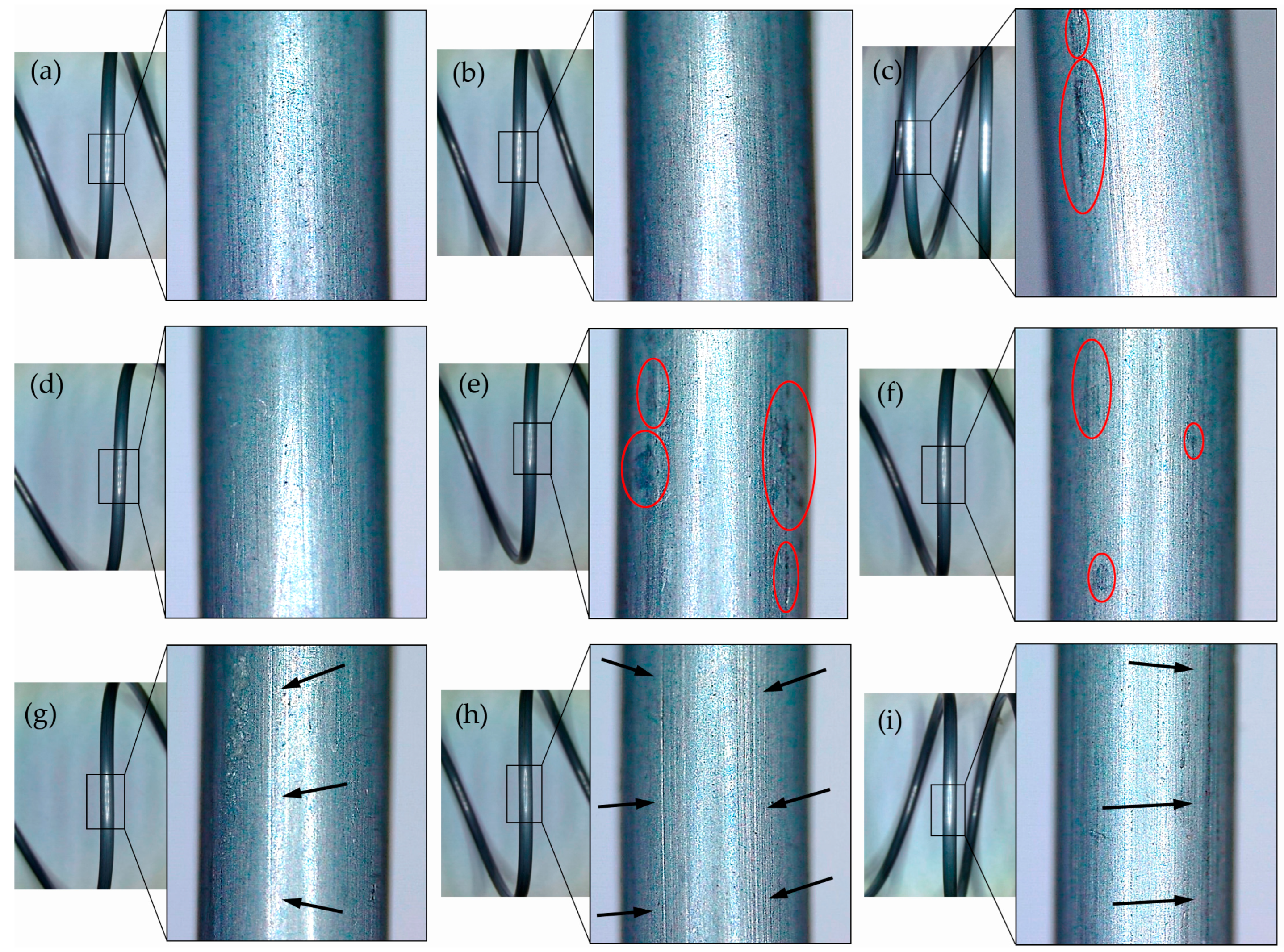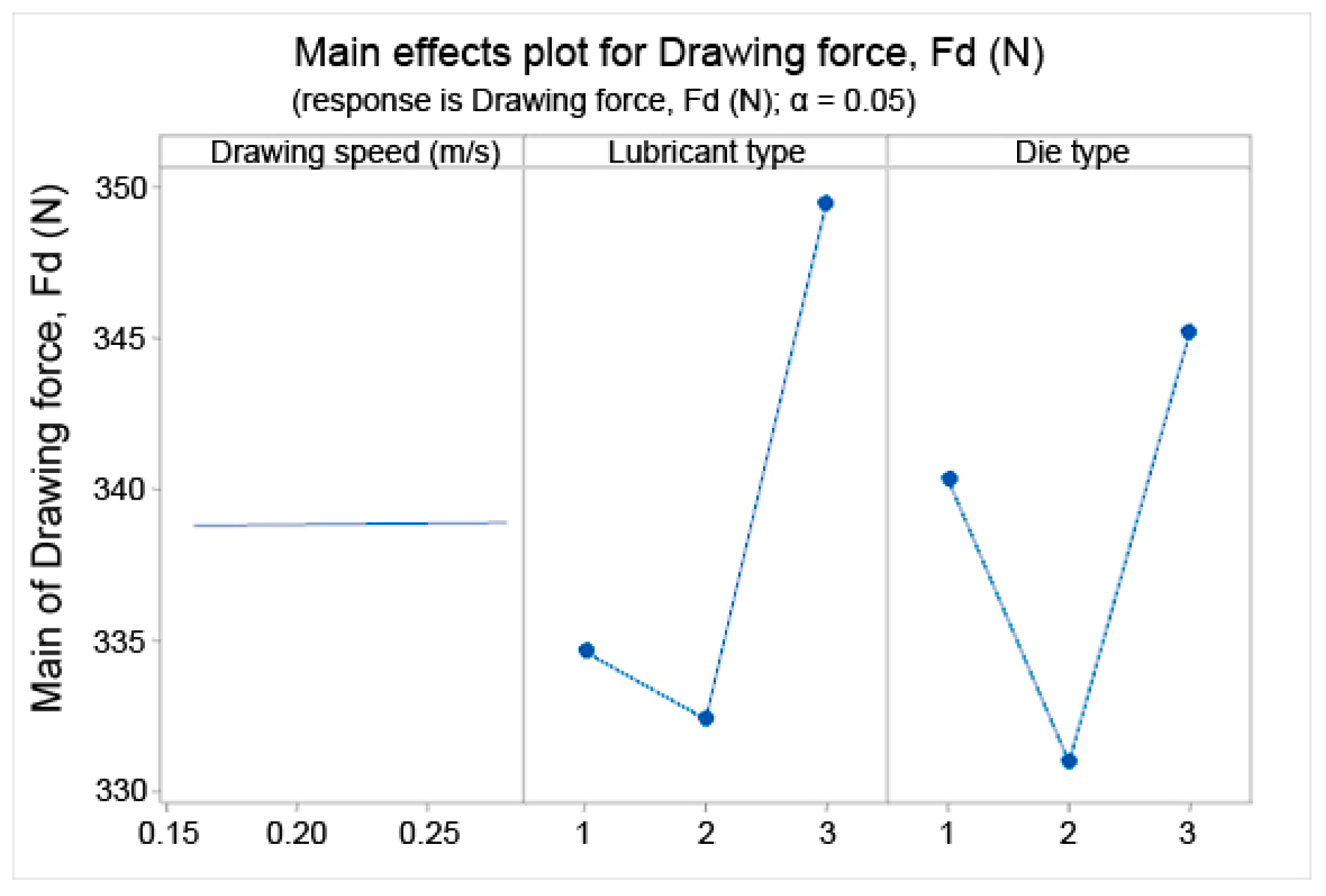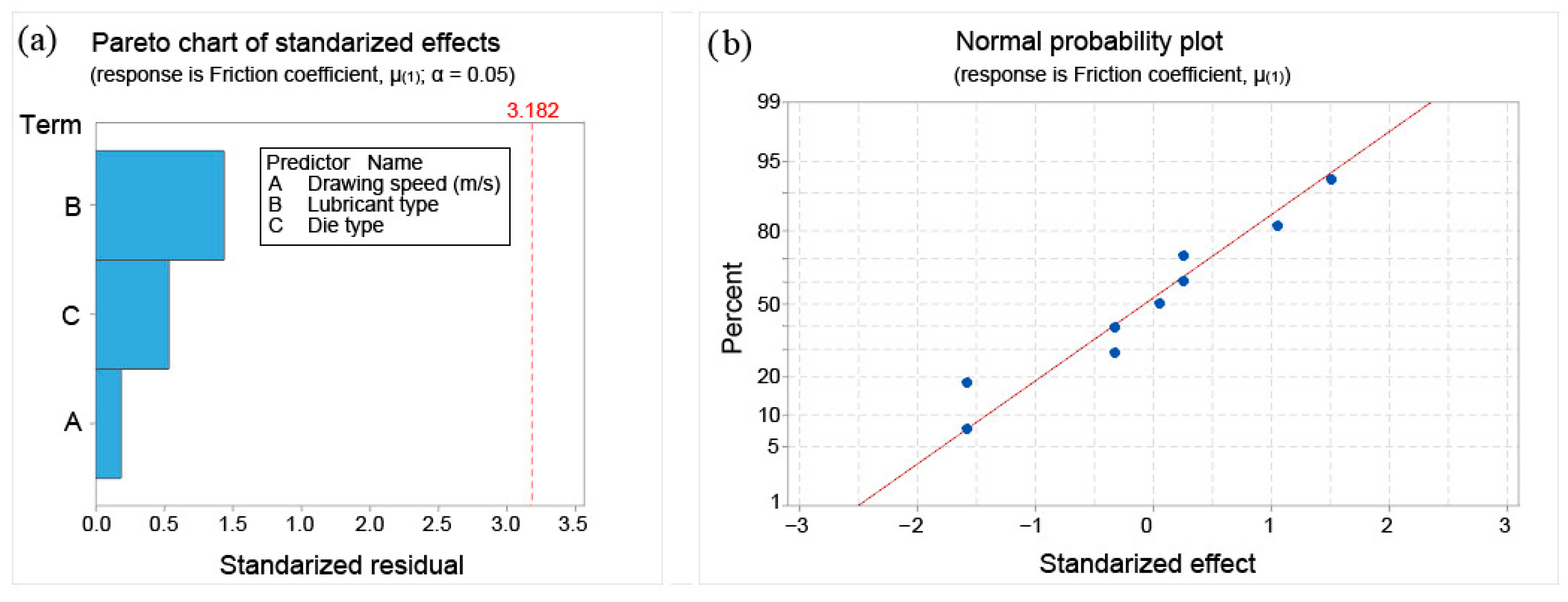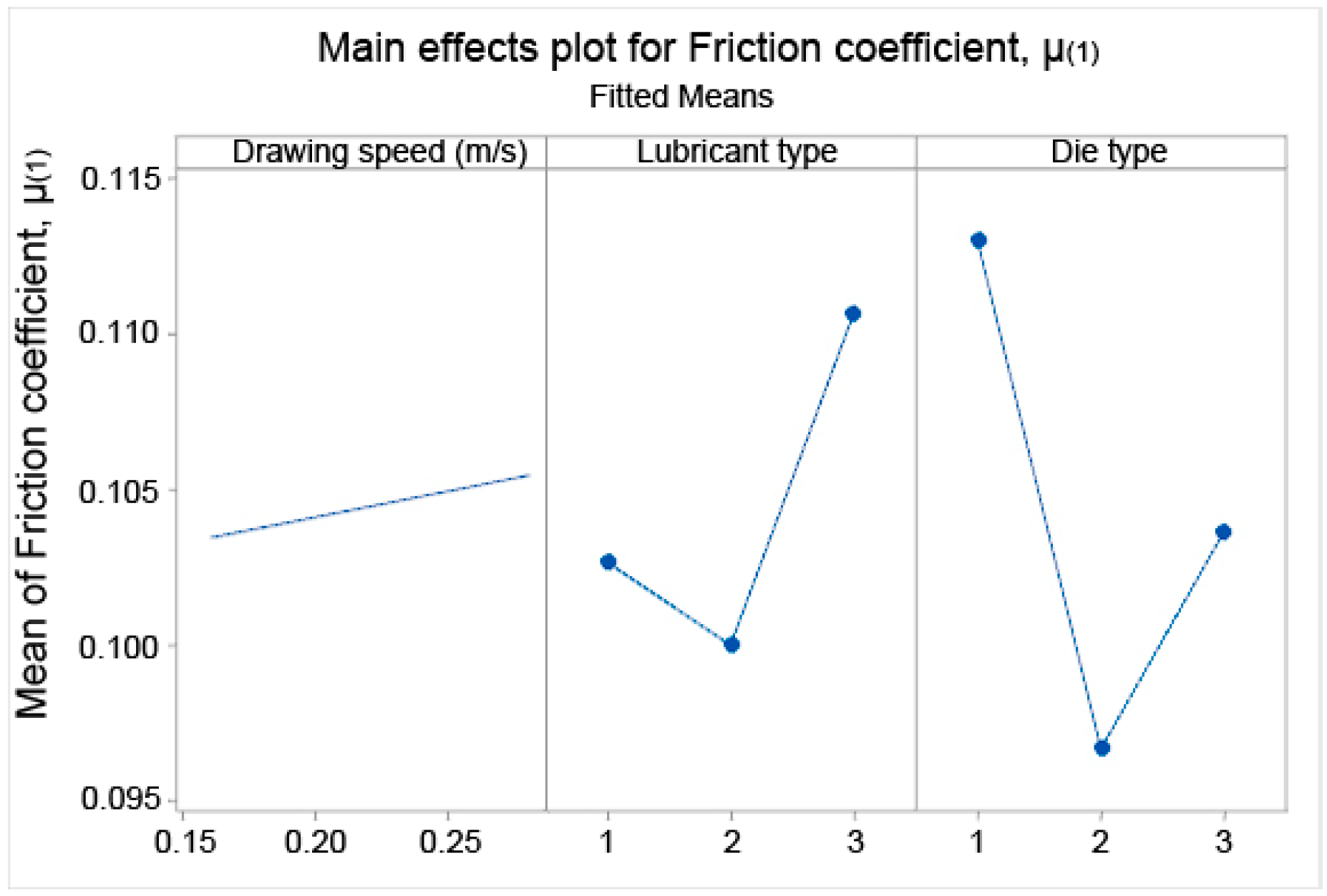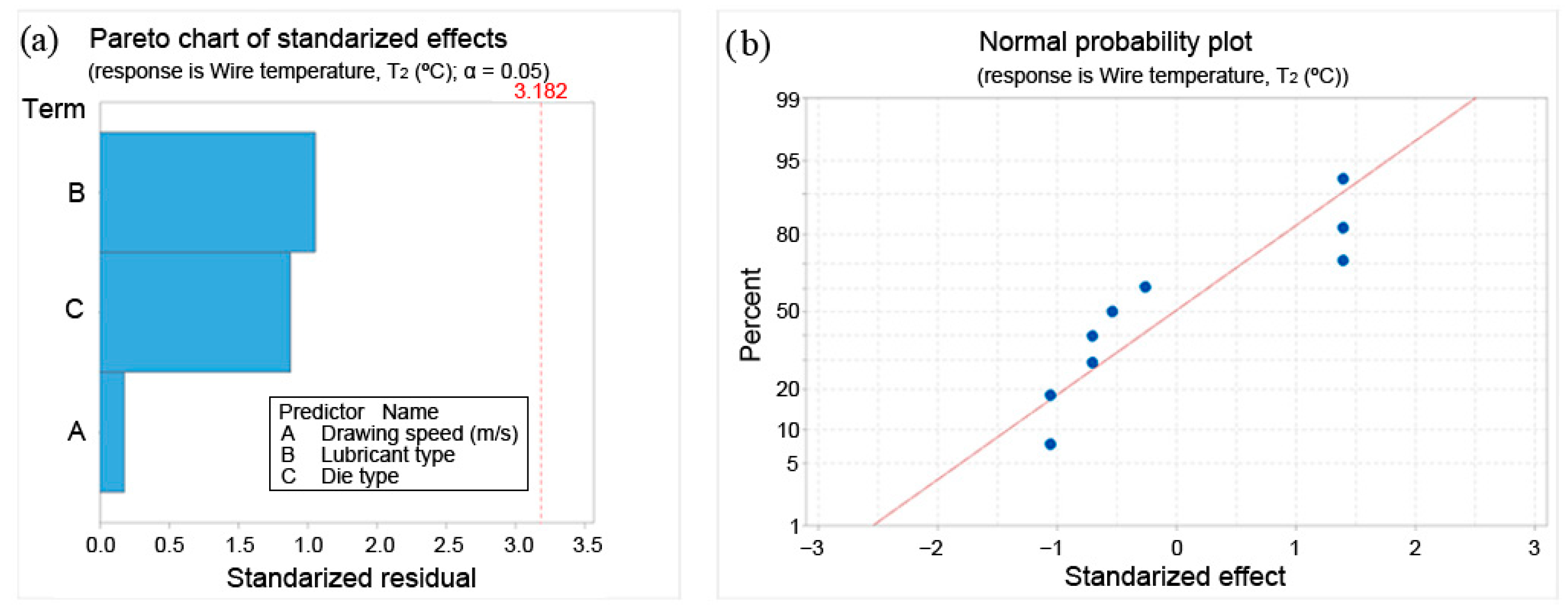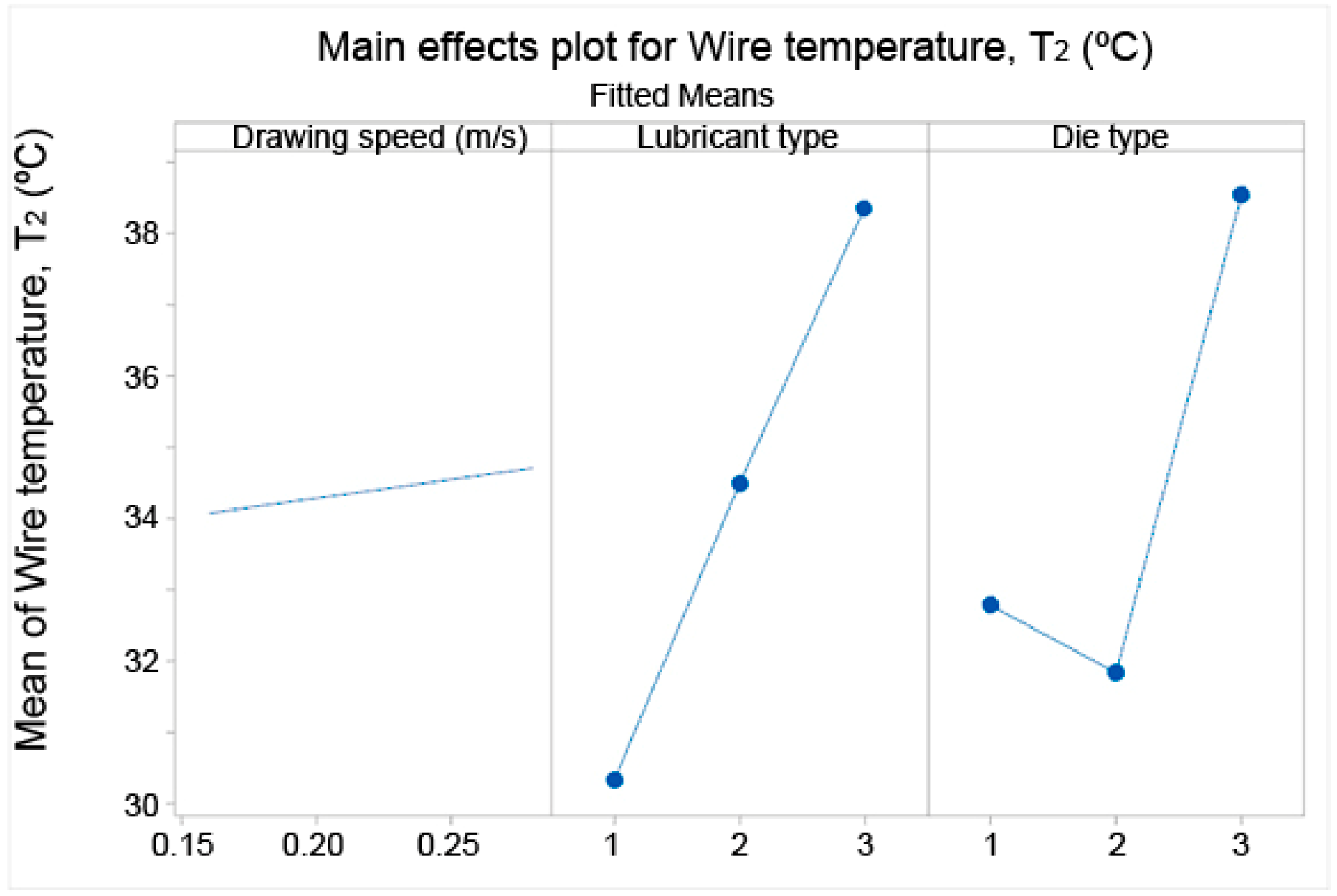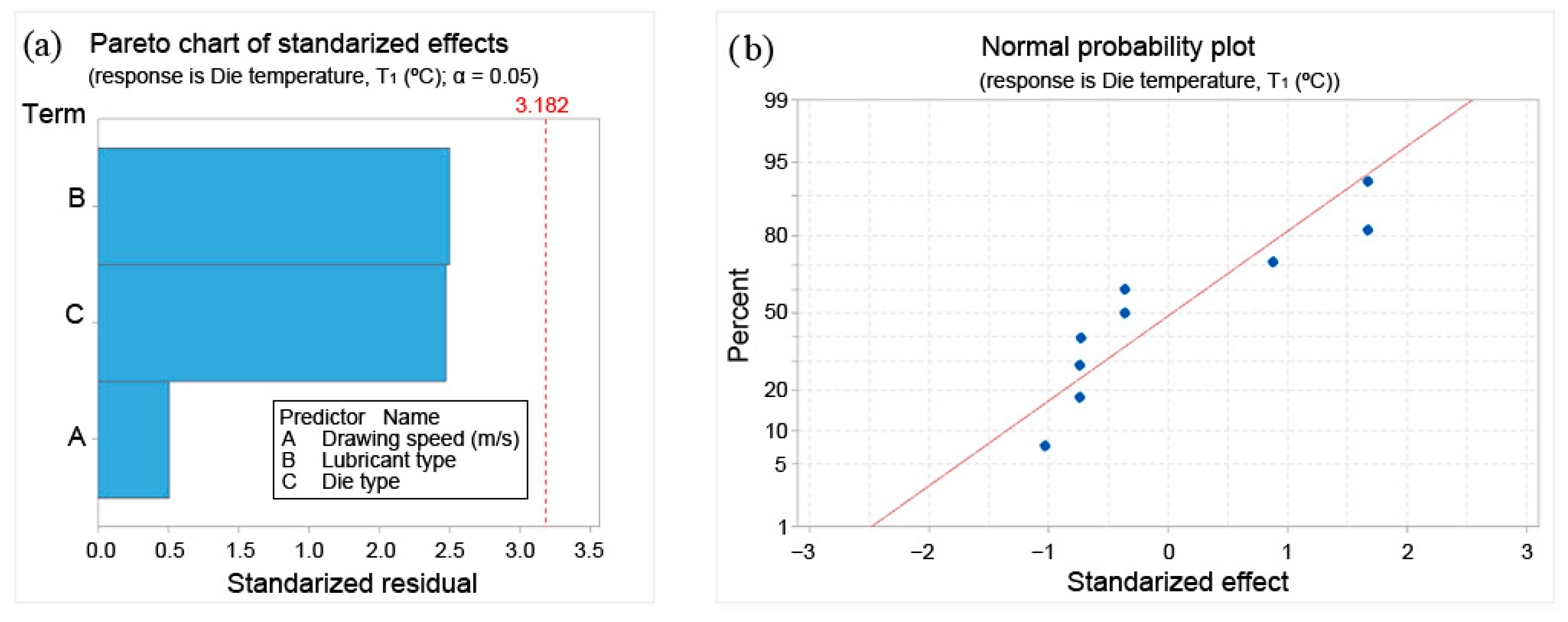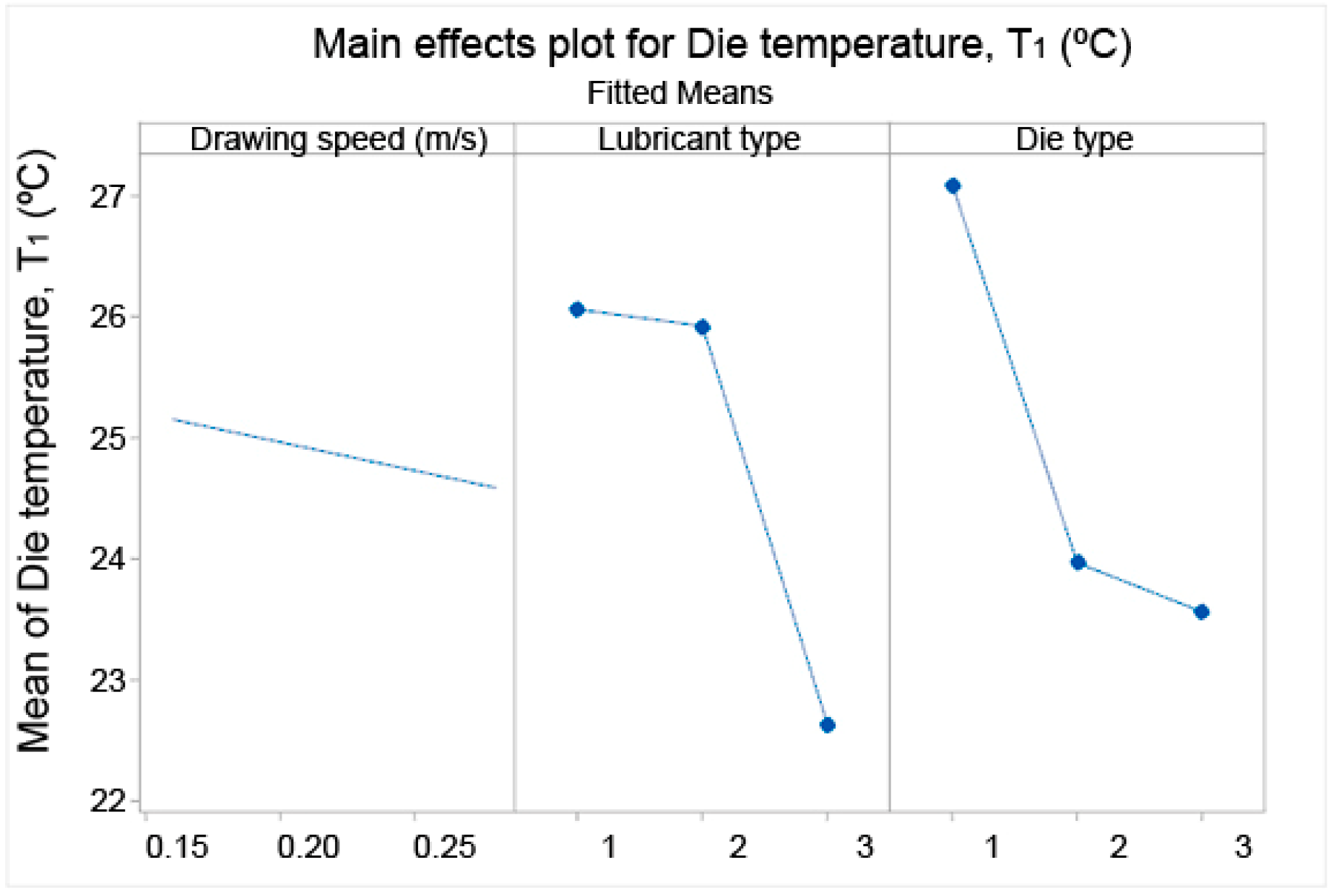1. Introduction
Zinc–aluminum alloys are commonly used as coatings for steel to provide corrosion protection, as zinc resists alkaline corrosion, while aluminum is resistant to acidic and neutral environments. Thus, previous works have corroborated that the corrosion rate of the Zn-Al coatings decreases as the Al content increases [
1,
2]. Conversely, ZnAl15% alloy has shown the highest microhardness and tensile strength with excellent corrosion resistance and the best wetting ability [
2,
3]. In addition, Zn–Al alloy coatings offer better mechanical performance than pure zinc coatings, with ZnAl15% being the most widely used alloy in regions with highly corrosive environments, such as maritime environments.
ZnAl15% alloy (85% Zn–15% Al) consumable wire for thermal spraying is produced by continuous casting of rods, followed by hot rolling [
4,
5] and multi-stage wire drawing to final diameters of 1.6–3.2 mm. Drawing is carried out through tungsten carbide or polycrystalline diamond dies with lubricants such as oils, emulsions, or powders to limit friction and heat, after which the wire is spooled, cleaned, and surface-protected against oxidation. Moreover, the wire drawing process faces several challenges: the alloy’s softness and stickiness increase the risk of adhesion to dies and unstable drawing conditions; lubricant choice strongly affects friction, force stability, and surface contamination; the low melting point (~380 °C) requires strict thermal control to avoid softening or breakage. Additionally, tight dimensional tolerances (±0.05 mm) must be maintained for spray-gun feedability, and surface cleanliness is critical, as residual oxides or lubricant films compromise later spraying performance.
The geometry of the drawing die is critical in wire drawing, as it determines the inlet and exit diameters and affects the distribution of stress and lubrication in the reduction zone. Conventional dies are commonly made of tungsten carbide and natural, synthetic, or polycrystalline diamond (PCD), which provide high wear resistance and excellent performance in demanding conditions. Currently, the market offers more advanced solutions with the design of hydrodynamic drawing dies. While in a conventional drawing die, the lubricant acts by gravity or inertia, hydrodynamic wire drawing dies are specialized tools designed to reduce friction and heat during the drawing of metals, particularly soft or non-ferrous alloys such as ZnAl15%. Unlike conventional dies, hydrodynamic dies feature an internal design that facilitates the injection of the lubricant media—oil, emulsion, or synthetic fluid—at high pressure through the die. As the wire passes, the relative motion generates a pressurized fluid film that separates the wire from direct die contact, significantly lowering the friction coefficient, reducing drawing forces, and minimizing wire and die temperatures. This mechanism also improves surface quality and extends die life by preventing local overheating and tool wear. As recent studies have demonstrated [
6,
7], hydrodynamic dies are especially advantageous for high-speed drawing or materials prone to sticking, providing enhanced process stability and product quality compared to standard lubrication methods [
8]. Thus, several key recent studies addressed advanced lubrication strategies and the influence of the die design in non-ferrous metal wire drawing.
Liquid superlubricity refers to a state of ultra-low friction achieved with specific liquid lubricants, minimizing wear and energy loss. In wire drawing, where high friction occurs at the die–wire interface, liquid superlubricity can reduce drawing force, decrease tool wear, and improve the surface quality of the drawn wire, resulting in smoother, defect-free products. According to Han et al. [
9], superlubricity can be achieved using water-based solutions, oil-based lubricants, or hydrated materials, among others. Thus, wire drawing with hydrodynamic–pressure dies could improve this condition by reducing friction and drawing force compared to conventional lubrication that occurs with standard drawing dies. Overall, optimizing lubricity in wire drawing offers a pathway to higher-quality wires, longer die life, and more energy-efficient, sustainable production. In this way, hydrodynamic lubrication occurs when a continuous fluid film fully separates the wire and drawing die, minimizing friction and wear, and being more effective at high drawing speeds, supported by suitable lubricant viscosity, die geometry, and surface finish. On the contrary, at lower speeds, the film becomes thinner, leading to mixed or boundary lubrication with increased friction. However, using high-viscosity lubricants, longer die angles, and pre-coated wires can help evaluate partial hydrodynamic effects and lubrication performance. Previous works that have been consulted have concluded that, at low values of drawing speed, the reduced drawing stress is lower when larger die semi-angles are used, while the exact opposite is valid at higher values of drawing speed [
7,
10,
11]. Thus, even if medium drawing speeds are used, it is possible to achieve better lubrication conditions when the viscosity and the semi-angle are optimal.
Previous works that have been consulted addressed the study of wire drawing under hydrodynamic conditions. Prisco et al. [
7] analyzed the effect of die pressure on the lubricating regimes achieved in the wire drawing of ETP copper, varying drawing speeds between 1 and 22 m/s, and comparing die semi-angles between α = 6° and 9° using conventional dies. They concluded that a higher die semi-angle allows for improvement in the lubrication regime even at low drawing speeds, while a lower semi-angle requires higher drawing speeds for this purpose. Tattershall et al. [
10] already attempted the study of favorable conditions to achieve a hydrodynamic lubrication regime in the wire drawing of copper and mild steel wires using soaps of widely varying rheological properties through a device consisting of a tube/nozzle at the entrance of the drawing die. They determined that the value of the entrance lubricant pressure depends on the clearance between the nozzle diameter and the wire and the length of the device. More recent works assessed the study using dies designed under this “hydrodynamic/pressure” concept. In this line, Suliga [
6,
12] investigated multi-stage wire drawing of high carbon steel from 5.5 mm to 1.7 mm at 5–25 m/s and using hydrodynamic dies, showing that at 25 m/s, uncontrolled surface and dimensional changes occur, while better quality has been obtained at lower speeds, 5–20 m/s. In a more recent work, Suliga et al. [
13] investigated the drawing process, comparing conventional and hydrodynamic dies working between 5 and 20 m/s with calcium–sodium grease as lubricant and analyzing the effect on the structure and corrosion resistance of hot-dip galvanized zinc coatings that have been applied to medium-carbon steel wire. They concluded that lower drawing speeds (below 20 m/s) yield better wire quality, since higher speeds increase friction and diffusion, causing thinner coatings and structural degradation. Additionally, the hydrodynamic die outperforms the conventional die, producing wires with thicker zinc layers, smoother surfaces, and improved mechanical properties.
In the wire drawing of zinc–aluminum alloys, effective lubrication also plays a key role in extending die life and improving drawn wire quality. Thus, the correct lubricant choice is very important. Previous works have corroborated that zinc stearate in the form of soap powder is a highly effective lubricant, significantly reducing drawing force and friction compared to other tested oils [
14]. However, studies have shown that low-viscosity oils or aqueous emulsions are more appropriate for achieving hydrodynamic regimes in wire drawing since solid lubricants cannot generate the necessary pressurized film and are, therefore, unsuitable [
7,
10]. Previous studies have investigated the Zn–Al alloy wire drawing process [
15,
16]; however, none have analyzed the advantages of pressure hydrodynamic dies in comparison with conventional dies, nor have they provided a systematic evaluation of different lubricant types. In this sense, although previously cited works have examined wire drawing under hydrodynamic conditions—mainly for copper or steel wires and typically at medium to high drawing speeds—the behavior of Zn–Al alloys, particularly ZnAl15%, under such regimes remains largely unexplored. In addition, existing research has focused on optimizing lubrication and die geometry at high speeds (≥5 m/s), whereas the combined influence of die design and lubricant type at low-to-medium drawing speeds has not been systematically analyzed. Moreover, most prior works have emphasized hydrodynamic effects or coating integrity in steel or copper systems, without addressing the tribological and thermal interactions specific to Zn–Al alloys, which exhibit distinct softening, adhesion, and low-melting-point challenges.
The main objective of this study is to comprehensively investigate the influence of lubricant selection, die configuration, and drawing speed on the tribological, mechanical, and thermal performance of thermally treated Zn–Al15% alloy during wire drawing, with particular emphasis on identifying the dominant parameters that govern drawing force and frictional behavior. The study aims to evaluate the comparative performance of conventional tungsten carbide dies and advanced hydrodynamic (pressure) dies under varying lubrication regimes to determine their impact on friction reduction and process efficiency. The secondary objectives include employing a Taguchi L9 experimental design to optimize key process parameters for minimal friction and improved drawing performance, establishing correlations between thermal and tribological responses to provide a data-driven framework for enhancing the overall efficiency and quality of Zn–Al wire drawing operations, and performing surface visual analyses of the drawn wires to evaluate the influence of lubrication and die configuration on surface quality.
The novelty of the present work lies in applying a Taguchi L9 (33) experimental design to quantitatively assess the relative effects of die geometry, lubricant formulation, and drawing speed in the low-speed regime (0.16–0.28 m/s) relevant for ZnAl15% alloy production. Unlike earlier studies, this research identifies lubricant selection as the dominant factor governing drawing performance, with hydrodynamic/pressure dies significantly reducing friction and drawing force, providing new insight into process optimization for Zn–Al alloys, where maintaining thermal stability and surface quality is critical. Overall, the findings provide a framework for optimizing process parameters in Zn–Al wire drawing, supporting improved control of mechanical, thermal, and surface outcomes.
2. Materials and Methods
The raw material for the present study is a ZnAl15% alloy wire with a diameter of 2.50 mm, supplied by Zinacor S.A. (Zinacor, S. A., Angleur, Belgium). This wire is produced by wire drawing from high-purity zinc–aluminum rods obtained through a Properzi continuous casting process [
4], ensuring compliance with the requirements of the UNE-EN ISO 14919:2015 standard [
17], which specifies the purity and quality of wires intended mainly for electric arc and flame spraying. The alloy has a density of 5.73 g/cm
3, a melting temperature of
Tm ≈ 382–450 °C, an ultimate tensile strength (σ
UTS) of the supplied wire between 110 and 150 MPa, and an elongation at break ranging from 70% to 200% according to the supplier’s material data sheet [
18]. The chemical composition of the alloy is presented in
Table 1.
Specimens of the wire, in its as-delivered state, were cut at 3 m in length from the supplied coil, which had been drawn to Ø2.18 mm by a sequential process in 3 passes.
Previous works consulted have demonstrated that a heat treatment at temperatures from 150 °C to 300 °C, with time intervals between 1 and 6 h, could be susceptible to optimizing Zn-Al15% alloy properties for the wire drawing process [
16,
19]. It concludes that a thermal treatment between 180 and 240 °C is sufficient to induce complete decomposition of α + η phase lamellae into coarse Al-rich α particles in the Zn-rich η matrix, improving the tensile strength of the alloy while maintaining a reasonable plastic deformation capacity. Thus, the specimens were subsequently rolled into 50 mm diameter coils onto a feeding mandrel and then subjected to heat treatment at 233 °C for 2 h, followed by slow cooling to room temperature in 24 h with the door closed, using a Nabertherm model N 11/HR oven (Nabertherm GmbH, Lilienthal, Germany), which is equipped with P320-model programmable controller with heating ramp selection that enables precise control of the thermal cycle (°C/min or °C/h). The thermal treatment homogenizes the mechanical properties of the wire, providing appropriate conditions for the final process. It should be noted that, in industrial practice, diameter reductions of about 9% are typically applied when working with this type of alloy using conventional drawing dies. However, the proposed experiment transforms a Ø2.18 mm ZnAl15% wire to Ø2.00 mm, which corresponds to a reduction of 15.83% without causing wire breakage or necking of the drawn wire during the experiments.
Figure 1 shows images of the supplied coil, specimens, and the oven used.
For the reduction from the supplied diameter to 2.18 mm diameter, a set of 3 conventional, standard-grade tungsten carbide drawing dies was used (Ø2.50 → Ø2.37 → Ø2.27 → Ø2.18 mm), reducing the area by nearly 9–10% per pass. These types of dies have been supplied by Frasan, S. L. (Frasan, S. L., Miranda de Ebro, Spain).
After specimen preparation and thermal treatment, a design of experiments (DoE) was intended to assess the performance of two pressure/hydrodynamic concept drawing dies (“19.38” high-grade tungsten carbide and “H3F” standard-grade tungsten carbide) and one conventional die (standard-grade tungsten carbide) in analog conditions. The pressure dies were supplied by the Vassena Filiere S.r.l. company (Vassena Filiere S.r.l., Lecco, Italy). Among these, the “19.38” concept represents Vassena’s new-generation solution, incorporating an innovative material and specialized geometry, particularly suited for final/small diameters on dry/wet drawing machines, with optimal results when combined with a pressure sleeve for increased productivity and die life. In contrast, “H3F” refers to a standard carbide nib/grade designation commonly used in conventional drawing dies but integrated into the same pressure/hydrodynamic die concept. The images in
Figure 2 show the design of a conventional drawing die compared to a double body in the case of a pressure/hydrodynamic drawing die.
A hydrodynamic (pressure) die is based on a multi-body design concept that incorporates a lubricant reservoir at the main inlet of the die body. Thus, previous works demonstrated that a specific design generates a hydrodynamic pressure due to the relative motion between the wire and die, which forces the lubricant into the pressure chamber, forming a continuous film that separates the wire and die surfaces [
21]. This film minimizes die-to-metal contact, thereby improving lubrication in the reduction zone, extending die service life, and allowing higher area reductions per pass. Additionally, the longer effective contact length improves wire quality due to the reduction in friction, which also lowers drawing temperatures [
22].
The hydrodynamic/pressure concept shown in
Figure 3 combines optimized geometry that forces the lubricant to accelerate through a constricted entrance zone (pressure die), in which a Venturi effect occurs—pressure drops and film thickness increases—creating effective forced lubrication. Unlike conventional dies, hydrodynamic designs promote partial or full hydrodynamic lubrication, significantly reducing friction and die wear while improving the surface quality of the drawn wire.
The wire-drawing sequence was performed on a vertical milling machine (model Lagun FTV-1, Lagun Machinery, S.L.U., Legutiano, Spain) adapted with a pulling spool, machined from EN-AW 6061 aluminum, and mounted on the spindle, which operated at controlled rotational speeds to generate the linear drawing speed (v) and drawing force (Fd). The die box has been designed to accommodate either type of drawing die, to hold a load cell, and to contain enough volume of lubricant. At the start of each test, the thermally treated wire specimen was placed on a free-feeding spool equipped with a crank handle. The setup has been perfectly aligned, keeping the wire horizontal relative to the table and die, while the milling machine’s vertical handwheel can be moved in the Z axis to ensure uniform winding on the pulling spool.
Drawing force (F
d) was measured with a Lorenz K-14 load cell (0.05–100 kN, stainless steel, IP60), with overall dimensions of Ø 30 × 9.4 mm and a central Ø 5.4 mm hole for wire passage (Lorenz Messtechnik GmbH, Alfdorf, Germany). It was mounted at the exit of the drawing die and connected to a Lorenz LCV model strain gauge interface, recording force vs. time data via USB with the VS3 Lorenz software version 3.06. In addition, each die was slotted transversely on the exit face to accommodate an MF55 series precision film-type NTC thermistor (Nanjing Shiheng Electronics Co., Ltd., Nanjing City, China) to measure die temperature at the exit face of the die (T
1), and an additional thermistor measured the wire temperature out of the die box (T
2). Both thermistors were calibrated against a PT100 platinum resistance thermometer of DIN Class A accuracy (±0.15 °C + 0.002 × |T|), which served as the reference sensor. The calibration was performed at two fixed points, 0 °C (ice–water bath) and 100 °C (boiling water), by exposing the thermistors and the PT100 to identical thermal conditions. The thermistor outputs at these reference temperatures were used to determine the calibration curve, ensuring that both sensors provided accurate and traceable temperature measurements throughout the experiments with a maximum temperature error of ± 0.2–0.3 °C. Temperature vs. time data have been recorded by the Arduino IDE software application v. 1.8.19 Arduino [
23]. The temperature of the wire at the exit of the drawing box (T
3) has also been measured with a thermal camera FLIR One Pro model (Teledyne FLIR LLC, Wilsonville, OR, USA) compatible with Android devices. This thermal camera has a measurement range of up to 400 °C, a sensitivity of 70 mK, and operates with a factory calibration that guarantees a maximum error of ± 3 °C (or ± 5% of the difference between ambient and scene temperatures) when the unit has been powered for at least 60 s, the ambient temperature is between 15 °C to 35 °C, and the scene (object) temperature is between 5 °C and 120 °C. Differences observed between the thermal camera and the contact sensors (thermistors and PT100) were, therefore, attributed to the camera’s intrinsic accuracy and emissivity-related effects. Equipment setup is described in
Figure 4.
In the proposed design of experiments (DoE), three different types of lubricants were used. Multidraw AL WM (Zeller + Gmelin GmbH & Co. KG, Eislingen/Fils, Germany) is a water-miscible synthetic oil (20% concentration) designed for aluminum wire drawing in intermediate and fine drawing processes, with a density of 960 kg/m3 at 15 °C and an average viscosity of 110 mm2/s at 40 °C. It is specifically based on synthetic esters enriched with anionic and nonionic surfactants, as well as inhibitors that enhance their performance. It provides excellent lubricating capacity, low foaming tendency, strong protection against microorganisms, and effective corrosion resistance. In addition, it exhibits high stability in the presence of electrolytes, making it particularly suitable for demanding applications. Multipress PEK (Zeller + Gmelin GmbH & Co. KG, Eislingen/Fils, Germany) is a mineral oil (100% oil) mainly used for pre-drawing and calibration drawing of high-strength steels, as well as stainless and acid-resistant steels, in single- or multi-stage processes. With a density of 980 kg/m3 at 15 °C and an average viscosity of 95–100 mm2/s at 20 °C, its composition is based on a pigmented mineral oil with sulfur-containing EP (extreme pressure) additives, which provide excellent resistance under demanding forming applications. Besal 35 (Brugarolas, S. A., Rubí, Spain) is a white micro-emulsifiable oil (8–10% oil + water) with a density of 1000 kg/m3 at 15 °C, with great cooling efficiency. This lubricant is designed for machining and forming processes, providing good corrosion protection and bacteriostatic stability.
It should be noted that the use of soap-based lubricants such as VICAFIL and STEELSKIN (from CONDAT) was initially considered during the preliminary design of the experiments. However, these lubricants were excluded from the present study because the wire-drawing tests were conducted on short wire lengths (approximately 1.5 m) and within a low process speed range in the laboratory setup. Under these conditions, the wire temperature would not be sufficient to melt the powder soaps, thereby preventing effective lubrication. Nevertheless, the potential of these lubricants for future research, particularly under higher drawing speeds and longer wire lengths, must be recognized.
The experimental design was based on a Taguchi L9 (3
3) orthogonal array, which allows the study of three factors at three levels each while reducing the number of required runs from twenty-seven in a full factorial design to only nine, as summarized in
Table 2. The factors considered were lubricant type (Multidraw, Multipress, and Besal), die type (Conventional, Pressure_19.38, and Pressure_H3F), and drawing speed (0.16, 0.22, and 0.28 m/s). This approach enabled an efficient evaluation of the main effects of these parameters on the drawing process output variables (drawing force and output temperatures) while maintaining robustness in the analysis. Each experiment was repeated twice, resulting in a total of 18 specimens to ensure reproducibility and to calculate mean values of the output variables.
For each experimental run, a 3 m in length and 2.18 mm in diameter specimen was thermally treated and then tapered at one of its ends using a wire-pointing machine to allow insertion through the die. The die was mounted in the die box together with the load cell, and the tapered end of the wire was fixed to the pulling spool. Thermocouples T
1 and T
2 were fixed in their working position, as shown in
Figure 3. Thus, the first one (T
1) has been positioned between the die and the load cell, and the second one (T
2) has been placed out of the die box, both in contact with the wire to record temperatures during drawing. Prior to each test, the die box was filled with lubricant, and the spindle was adjusted to the required drawing speed, with the corresponding conversion from linear speed (m/s) to spindle rotational speed (rpm) provided in
Table 2. Once the experimental run was launched, the drawing force (F
d) and the wire temperature data T
1 and T
2 were registered as a function of time, and T
3 was recorded in video format. During the drawing experiment, the Z axis in the machine was gradually displaced so that the wire was wound properly without overlapping on the pulling coil. At the end of the drawing operation, the wire was wound onto the left-hand drum (
Figure 3), and the die was removed from the die holder to allow the excess lubricant to drain. Steps from the die insertion to the wire collection were repeated for the second sample. The die holder and die were carefully cleaned of lubricant, and the samples from each experiment were labeled accordingly.
In the drawing of ductile metals and alloys, the coefficient of friction (µ) can vary significantly depending on lubrication quality, material properties, and drawing conditions. When the deformation zone is adequately lubricated, the coefficient of friction can typically be reduced within the range of µ = 0.1–0.3 when a ductile alloy (wire) and tungsten carbide (die) are in contact [
24,
25,
26]. Then, a simpler approach to calculate the coefficient of friction is to determine this constant using Equation (2), which derives from the drawing tension calculation Equation (1) proposed by [
27,
28].
The drawing stress (σd) can be calculated as a function of the drawing force measured in the experiment (Fd) and the cross-sectional area of the drawn wire (Af), while the die shape form factor (Δ) describes the geometry of the reduction zone in the drawing die as a function of the mean diameter (dm) and the contact length (L), both dependent on the input wire diameter (d0), the output wire diameter (df) and the reduction semi-angle (α).
Furthermore, the yield stress (σY) of the input wire is implicit in Equation (2). Accordingly, tensile tests were carried out on thermally treated Ø2.18 mm ZnAl15% alloy specimens, yielding a mean value of σY = 181 MPa after five repetitions.
Previous studies demonstrated that the hardening behavior of high Zn-content and Zn–Al alloys depends on strain, strain rate, temperature, and grain structure since this type of alloy exhibits low recrystallization temperatures, favoring its plastic deformation at ambient conditions (typical in wire drawing) and a superplastic behavior characterized by large elongations before breakage under specific conditions [
29,
30]. This behavior, often associated with grain-boundary sliding and rotational ability, reduces flow stress and enhances ductility. Nevertheless, it should be considered that the key requirement in wire drawing is a material with sufficient ductility at room temperature, avoiding localized necking that would compromise material continuity and cause fractures during the process. Consequently, this work has been proposed to use the strain-rate sensitivity model described by Equation (4) for the determination of the evolution of the yield limit as a function of the strength coefficient of the alloy (K), average true strain rate
, and strain-rate sensitivity coefficient (m).
To obtain the value of the strain rate sensitivity coefficient m, the points (σ
1,
1) and (σ
2,
2) in
Figure 4a have been adjusted, particularizing with the experimental values obtained from tensile tests (
Figure 4b), as indicated in
Table 3 and in Equation (7). Thus,
and
denote the strain rates corresponding to σ
UTS and σ
Y, respectively. Previous works have reported the empirical correlation between the ultimate tensile strength (Rm or σ
UTS) and conventional yield strength (Rp
0.2 or σ
Y) with the applied strain rate
[
31,
32]. Then, when differences in σ
UTS and σ
Y arise primarily from variations in strain rate—such as those induced by different testing speeds in the plastic period, as shown in
Figure 5—the strain rate sensitivity exponent (m) can be estimated by Equation (7), which has been deduced by fitting the experimental data to Equation (6) and by applying logarithms to the relationship deduced from
Figure 5a and Equation (5).
The strain-rate sensitivity coefficient (m) was determined through uniaxial tensile tests on ZnAl15% Ø2.50 mm wire specimens (150 mm total length, 100 mm gauge length) following UNE-EN ISO 6892-1:2020 [
33]. Specimens were first loaded at 0.00025 s
−1 up to the yield point to ensure consistent elastic–plastic transition, after which tests were performed in the plastic region at crosshead speeds of 12.5–100 mm/min, corresponding to strain rates from 0.00208 to 0.02500 s
−1 (Equation (8)).
After determining the strain-rate sensitivity coefficient (m), the strength coefficient (K) can be calculated by substituting it into Equation (4). The values of the strain-rate sensitivity exponent (m) and the coefficient of resistance (K) are shown in
Table 4, and the mean values obtained for these coefficients define the material behavior model of ZnAl15% alloy wire that has been thermally treated, as expressed by Equation (9), which models the evolution of the alloy’s yield limit.
The study of the dimensional and surface quality of the drawn wire has complemented the work. For this, the final diameter of each drawn wire sample has been measured with a Mitutoyo micrometer with a measuring range from 0 to 25 mm and an accuracy of 0.001 mm (Mitutoyo Corporation, Takatsu-ku, Kawasaki, Kanagawa, Japan). It has then been photographed using the Leica DVM6 digital microscope (Leica Microsystems GmbH, Wetzlar, Germany), which provides a magnification range from 12× to 2350× with a resolution of up to 0.4 µm. Image acquisition and analysis were performed by the Leica Application Suite X (LAS X) software version 5.3.1, which enables reproducible parameter settings and advanced features such as extended depth of field and HDR imaging. Appropriate magnification and illumination were selected to highlight surface features such as defects, dirt, and wear, ensuring high-quality and consistent image documentation.
Once the experimental plan was executed, the results were statistically analyzed using Minitab software, version 19 (Minitab LLC, State College, PA, USA), applying regression and ANOVA models to evaluate the influence of the input variables of this study on each of the measured output variables.

